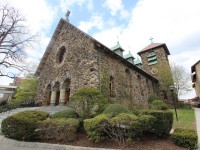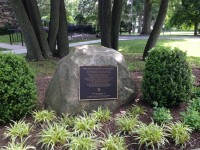The Good Counsel Complex, A Fixture in White Plains History

June 25th marked the 119th anniversary of the laying of the cornerstone of The Chapel of the Divine Compassion in White Plains.
An article in the June 23, 1895 edition of The New York Times described the groundbreaking ceremony and the building of the chapel as an important event at the time. “The cornerstone of a handsome chapel, to be built by the Sisters of the Divine Compassion to the memory of Msgr. Preston, founder of their order, will be laid with imposing ceremonies by Archbishop Corrigan. It will be on Good Counsel Farm, Broadway, and a general invitation to be present is extended to the people of the village and its vicinity,” the article said.
It went on to describe the chapel as “a valuable addition to the architecture of the County seat, and to its most beautiful and attractive thoroughfare – Broadway.”
A special train was scheduled to leave Grand Central Station in New York on the Harlem line to bring the archbishop and guests to the auspicious event, The New York Times article said.
Archbishop Corrigan administered the Catholic sacrament of Confirmation to several of the girls living on the Good Counsel Farm before the cornerstone ceremony.
Today, the chapel still sits on the same hallowed ground, chosen by its designer Mother Mary Veronica, formerly Mary Caroline Dannat Starr, the wife of a New York City industrialist, and several of the original Sisters of the order she founded – The Sisters of the Divine Compassion.
Letters written by the Foundress and published in a biographical book about her life, “The Fruit of His Compassion” by Sister Mary Teresa, RDC, copyright 1962, Pageant Press Inc., New York, describe the moments when standing on the hill under a grove of trees, the inspiration struck her to build a chapel to house the remains of her spiritual mentor and co-founder of the religious order Msgr. Preston. She wrote that she was quite moved as well to dedicate the spot as the final resting place for herself and other Sisters following in the order.

The property on which the chapel stands was originally the site of the Prudhomme house that became the first convent for the Sisters in White Plains. To make room for the chapel, the house was moved to the back of the property and later became Our Lady of Good Counsel Academy Elementary School. The elementary school continues to use classrooms in the historical building today.
Mary Mother Veronica, was a woman of the world, highly educated, well traveled and with an inheritance of her own that allowed her to carry forth her vision.
The chapel, which cost $50,000 to construct, was built in the early Gothic style of architecture with uncut grey stone and a roof of red slate, patterned after the Church of St. Charles Borremeo, Milan, Italy. It was built in the form of a cross with a large clock tower on the south side, including bells that continue to ring today.
Inside the building, artwork in the form of paintings and sculpture, created specifically for the chapel and the Sisters of the order tell not only the story of their religion but of their order as well. Stained glass windows, developed by an apprentice of Tiffany, adorn the sidewalls and upper gallery. The altar is breathtaking with a statue of the risen Christ welcoming visitors with outstretched arms. The acoustics developed to enhance music of the human voice as well as traditional instruments, continues to enthrall concertgoers as well as musicians who use the space to listen to their music in its most pure form. The crypt, below ground, though it is smaller in size, is similar to those found in the cathedrals of Europe.
Mother Mary Veronica was a renaissance woman of her time. Using the tools given to her by her social status, she created a school and home for young women and girls to take them off the streets and empower them with the tools they needed to live productive lives. That mission continues today on the campus through the order’s various ministries and the students who pass through, graduating with not only a solid education, but also with a deep sense of compassion for the world in which they live.
The Sisters of the Divine Compassion will celebrate the 145th anniversary of their founding mission in 2015.
